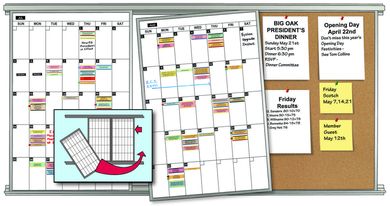Magnatag InSight
The whiteboard and how it helps us brainstorm, innovate, motivate and create
RECENT BLOG POSTS
- How to Eliminate Scheduling Chaos with the Right Business Calendar
- The Educators’ Choice: 8 Leading Whiteboards for Group Learning
- Glass vs Porcelain vs Melamine: Which Magnetic Dry Erase Surface Lasts Longest?
- Full‑Wall Whiteboard Panels vs Paint: Performance, Cost, and Longevity Compared
- The Definitive Guide to Creating High‑Quality Branded Whiteboards with Magnatag
- Glass vs. Porcelain: Which Whiteboard Surface Fits Modern Offices Best?
CATEGORIES

How Trial Lawyers Are Using Calendars To Streamline Focus & Encourage Productivity
Wed Apr 26 2017By: Mike P
Somewhere between 95% and 96% of all personal injury cases are settled pretrial. For the 4% to 5% that are unable to compromise outside of the courtroom, there’s Jim Nugent. Working as the lead trial lawyer for the Nugent & Bryant law firm based out of New Haven, Connecticut, Jim frequently finds himself juggling multiple cases throughout the course of the year.
“The last four months of any case are where everything you’ve been working towards begins to come into play. I like to call those last four months the “big crunch” because at times there can be a lot of deadlines in play and you’ve got to find a way to manage it”, says Nugent.
One of the many ways Nugent manages his time is with the help of a scheduling technique he refers to as “time-blocking”. After reading a pair of books (Miracle Morning—Hal Elrod and The One Thing—Gary Keller) that emphasized the idea of isolating time out of your day for one specific task, Nugent thought that a similar approach could be used when managing his casework. He began blocking out set periods of time for individual casework to serve as a visual for how long projects have to be completed.
In order to make the most out of his scheduling methodology, Nugent looked-for a tangible solution to scheduling and coordinating important case details and milestones. While the firm’s pre-existing scheduling software worked just fine, it ultimately wasn’t enough. The digital calendar was part on an entire software package—one the firm has been using since 2002. The software itself presents limitations to how a schedule can be composed, which ultimately compromised simplicity of Nugent’s time-blocking technique. What was needed was a scheduling system that could track multiple projects in a central, easy-to-read location.
The solution: Magnatag’s Modular Month-to-Month Dry Erase Calendar system. The calendar allows for months to be viewed in a perpetual and expanding fashion, with each individual panel representing a single month. Panels can be rearranged as necessary by sliding in and out of the mounted track, guaranteeing your schedule is always up-to-date. With the addition of magnetic cardholders to label important dates and events, the modular calendar system can be easily maintained and altered. “For me, I like to think of time-blocking as the main principal of getting things done. The month-to-month calendar helps me do just that. I currently have the board set up at my home office, managing seven individual cases over a four-month span. I’m using the magnetic cardholders to indicate different all the different steps and deadlines involved in the process: red indicates trial dates, blue for motions—it all comes together to make visualizing my schedule and time-blocking a much easier process”
“For me, I like to think of time-blocking as the main principal of getting things done. The month-to-month calendar helps me do just that. I currently have the board set up at my home office, managing seven individual cases over a four-month span. I’m using the magnetic cardholders to indicate different all the different steps and deadlines involved in the process: red indicates trial dates, blue for motions—it all comes together to make visualizing my schedule and time-blocking a much easier process”
The average life of a lawsuit can range anywhere from 12-18 months depending on the circumstances. Between discovering deadlines, filing motions, and preparing depositions, Jim’s ultimately working towards one end result: the trial.
Nugent first experimented by creating a rudimentary calendar layout on a plain dry erase board. Using different colored markers to highlight specific cases, this board served as a proof of concept for a scheduling system that best suited his individual needs. With the help of the design team over at Magnatag Visible Systems, Nugent was able to build upon his original concept and find a scheduling system that made the time-blocking system painless.
“The last four months of any case are where everything you’ve been working towards begins to come into play. I like to call those last four months the “big crunch” because at times there can be a lot of deadlines in play and you’ve got to find a way to manage it”, says Nugent.
One of the many ways Nugent manages his time is with the help of a scheduling technique he refers to as “time-blocking”. After reading a pair of books (Miracle Morning—Hal Elrod and The One Thing—Gary Keller) that emphasized the idea of isolating time out of your day for one specific task, Nugent thought that a similar approach could be used when managing his casework. He began blocking out set periods of time for individual casework to serve as a visual for how long projects have to be completed.
In order to make the most out of his scheduling methodology, Nugent looked-for a tangible solution to scheduling and coordinating important case details and milestones. While the firm’s pre-existing scheduling software worked just fine, it ultimately wasn’t enough. The digital calendar was part on an entire software package—one the firm has been using since 2002. The software itself presents limitations to how a schedule can be composed, which ultimately compromised simplicity of Nugent’s time-blocking technique. What was needed was a scheduling system that could track multiple projects in a central, easy-to-read location.
The solution: Magnatag’s Modular Month-to-Month Dry Erase Calendar system. The calendar allows for months to be viewed in a perpetual and expanding fashion, with each individual panel representing a single month. Panels can be rearranged as necessary by sliding in and out of the mounted track, guaranteeing your schedule is always up-to-date. With the addition of magnetic cardholders to label important dates and events, the modular calendar system can be easily maintained and altered.
 “For me, I like to think of time-blocking as the main principal of getting things done. The month-to-month calendar helps me do just that. I currently have the board set up at my home office, managing seven individual cases over a four-month span. I’m using the magnetic cardholders to indicate different all the different steps and deadlines involved in the process: red indicates trial dates, blue for motions—it all comes together to make visualizing my schedule and time-blocking a much easier process”
“For me, I like to think of time-blocking as the main principal of getting things done. The month-to-month calendar helps me do just that. I currently have the board set up at my home office, managing seven individual cases over a four-month span. I’m using the magnetic cardholders to indicate different all the different steps and deadlines involved in the process: red indicates trial dates, blue for motions—it all comes together to make visualizing my schedule and time-blocking a much easier process”
The average life of a lawsuit can range anywhere from 12-18 months depending on the circumstances. Between discovering deadlines, filing motions, and preparing depositions, Jim’s ultimately working towards one end result: the trial.
Nugent first experimented by creating a rudimentary calendar layout on a plain dry erase board. Using different colored markers to highlight specific cases, this board served as a proof of concept for a scheduling system that best suited his individual needs. With the help of the design team over at Magnatag Visible Systems, Nugent was able to build upon his original concept and find a scheduling system that made the time-blocking system painless.